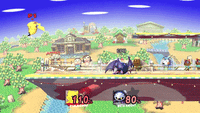| Welcome to SmashWiki! Log in or create an account and join the community, and don't forget to read this first! |
| Notices |
|---|
| The Skill parameter has been removed from Smasher infoboxes, and in its place are the new "Best historical ranking" and "Best tournament result" parameters. SmashWiki needs help adding these new parameters to Smasher infoboxes, refer to the guidelines here for what should be included in these new parameters. |
| When adding results to Smasher pages, include each tournament's entrant number in addition to the player's placement, and use the {{Trn}} template with the matching game specified. Please also fix old results on Smasher pages that do not abide to this standard. Refer to our Smasher article guidelines to see how results tables should be formatted. |
| Check out our project page for ongoing projects that SmashWiki needs help with. |
Stage jump
A stage jump refers to the act of travelling under a stage with a character and returning on the other side. They can be performed on any stage that has a large, hard platform and can be jumped under, such as on Smashville or Hyrule Temple. As the undersides of stages are long in distance and require the player to prevent themselves from crossing the lower blast line, most stage jumps can only be performed by a small pool of characters that have long, varied recovery options, such as Jigglypuff or Meta Knight. The Temple jump is the most well-known stage jump in the series, due to every single character being able to perform it.
Stage jumps can be performed in all games of the series, as all the installments have featured multiple stages that can accommodate the technique. They can be used to potentially surprise opponents while recovering, though many stage jumps can only be performed on stages that are not tournament legal, such as Corneria or New Pork City.
